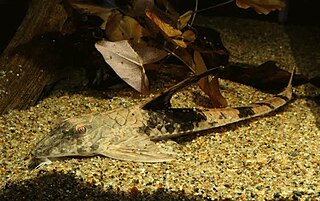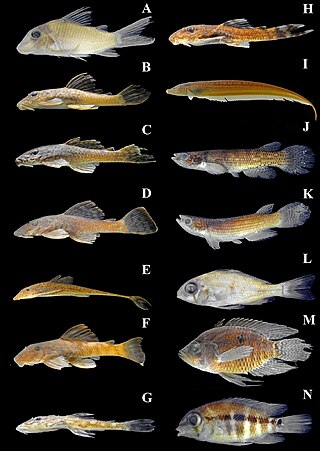
Loricariidae is the largest family of catfish, with over 90 genera and just over 680 species. Loricariids originate from freshwater habitats of Costa Rica, Panama, and tropical and subtropical South America. These fish are noted for the bony plates covering their bodies and their suckermouths. Several genera are sold as "plecos", notably the suckermouth catfish, Hypostomus plecostomus, and are popular as aquarium fish.

Hypostomus is a genus of catfish in the family Loricariidae. They are native to tropical and subtropical South America. H. plecostomus is the popular freshwater aquarium fish formerly known as Plecostomus plecostomus. The taxonomic structure of the Loricariidae is still being expanded by scientists. Hypostomus is a highly species-rich and widely distributed catfish genus.

Baryancistrus is a genus of freshwater Loricariid catfish. They inhabit flowing sections of rivers, especially clearwater, in the basins of the Amazon and Orinoco in Brazil and Venezuela. The largest species reach up to 34 cm (13 in) in total length.

Rineloricaria is a genus of freshwater tropical catfish belonging to the family Loricariidae. They are commonly called whiptail catfish because of the long filament that grows out of the tip of the caudal fin that is characteristic of the genus. With the exception of R. altipinnis from Panama, they are native to the rivers of northern and central South America. Some species are regularly seen in the aquarium trade.

Peckoltia is a genus of small South American armored suckermouth catfishes. Many of these fish are popular aquarium fish.

Farlowella is a genus of fish in the family Loricariidae native to South America. This genus is broadly distributed in Amazon, Orinoco, Paraná and coastal rivers of the Guyana Shield. It is absent from the Pacific slope of the Andes and from the coastal rivers of the Brazilian Shield. Many of these species are kept in aquariums. This genus has a unique body shape that resembles a thin stick of wood. The body is slender and elongate, often with a pronounced rostrum and a brownish color with two lateral dark stripes beginning at the tip of the rostrum, passing over the eyes and ending at the tail, which are periodically interrupted on the caudal peduncle.

Loricariinae is a subfamily of the family Loricariidae of catfish. This subfamily is divided into two tribes and about 30 genera. They are mainly native to freshwater habitats in South America, but there are also several species in Panama and a single (Fonchiiichthys) in Costa Rica.
Limatulichthys griseus, is a species of catfish in the family Loricariidae.
Reganella depressa is the only species of the monotypic genus Reganella, a genus of the family Loricariidae of catfish. R.depressa is a poorly known species and uncommon in collections. Its phylogenetic position remains uncertain.
Rhadinoloricaria is a genus of catfish endemic to South America. It was considered to be monotypic until the 2020 discovery of a second species.
Ixinandria steinbachi is the only species in the genus Ixinandria of catfish of the family Loricariidae.

The Hypoptopomatinae are a subfamily of catfishes of the family Loricariidae, composed of 17 genera and approximately 80 species. This subfamily represents about one-tenth of all loricariid species.
Pareiorhaphis is a genus of catfish in the family Loricariidae native to South America. This genus can be readily distinguished from other neoplecostomines by the unique combination of having fleshy lobes on lateral margins of head ornamented with hypertrophied odontodes on nuptial males, caudal peduncle ovoid in cross section, abdomen usually naked, dorsal fin spinelet ovoid and adipose fin usually present. The color pattern is usually dark brown and mottled with the abdomen white. Most species in to Pareiorhaphis were originally described in Hemipsilichthys. In 1918, Alípio de Miranda-Ribeiro proposed the new genus Pareiorhaphis. Whether Pareiorhaphis is monophyletic or not is currently unknown.

Loricaria is a genus of armored catfish native to South America.

Neoplecostomus is a genus of fish in the family Loricariidae native to South America. Neoplecostomus can be distinguished from all other loricariids by a modified shield of small plates on the abdomen with posteriorly directed odontodes; the shield appears to act as a holdfast. The color pattern is generally mottled brown with the abdomen white. The head is long, rounded, and shovel-shaped. The fin spines are weak. They range from about 8 to 11 cm (3.1–4.3 in) SL. The species of Neoplecostomus live in fast-flowing water.

Spatuloricaria is a genus of armored catfishes native to South America and Panama.
Fonchiiichthys uracanthus is a species of armored catfish native to Costa Rica and Panama. However, Fonchiiichthys has recently been considered to be a synonym of Rineloricaria and thus may be invalid. This species grows to a length of 16.5 centimetres (6.5 in) SL.

Panaqolus is a genus of small catfish in the family Loricariidae native to rivers in tropical South America. Its members were formerly thought to belong to a clade of small-sized species in the genus Panaque, until this genus was separated from Panaque in 2001. At times it has been considered a subgenus of Panaque, and the validity of the genus has been disputed by various authors and sources. Pseudoqolus koko was formerly considered to be a member of this genus, although it was reclassified as a member of the currently monotypic genus Pseudoqolus by Nathan K. Lujan, Christian A. Cramer, Raphael Covain, Sonia Fisch-Muller, and Hernán López-Fernández following a 2017 molecular phylogenetic analysis.
Harttia absaberi is a species of armored catfish where it is found in the upper rio Paraná drainage in Brazil.

Cteniloricaria napova is a species of catfish in the family Loricariidae. It is native to South America, where it occurs in the upper Paru de Oeste River basin in Suriname. The species reaches 12.9 cm (5.1 in) in standard length and is believed to be a facultative air-breather. Its specific name, napova, is derived from the Tiriyó language and means "thank you", honoring the Tiriyó people of Sipaliwini District for collecting and providing specimens of the species.











